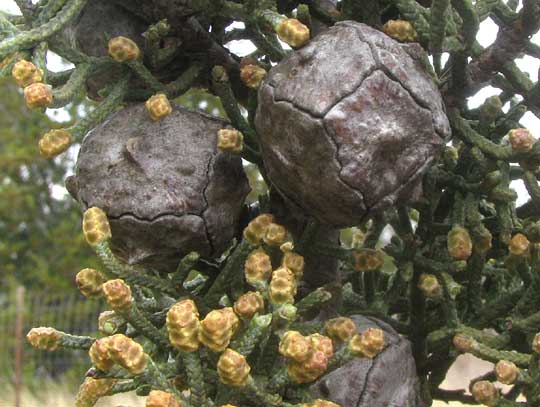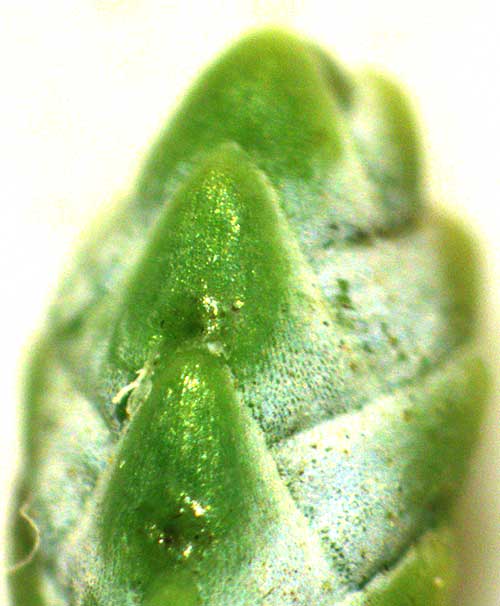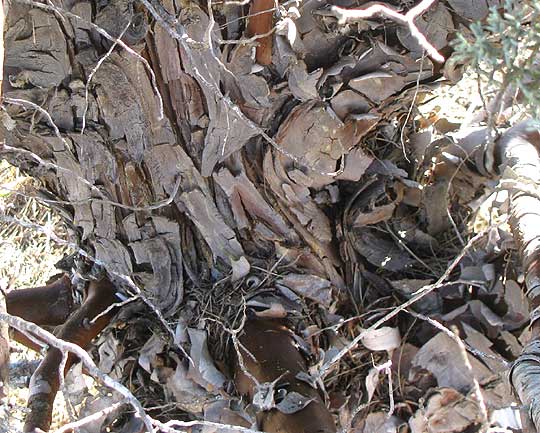Excerpts from Jim Conrad's
Naturalist Newsletter
from the January 13, 2013 Newsletter issued from the valley of the Dry Frio River in northern Uvalde County, southwestern Texas, on the southern border of the Edwards Plateau; elevation ~1750m (~5750 ft); N29.62°, W99.86°; USA
ARIZONA BLUE CYPRESS
In rural western Kentucky I grew up near Cypress Creek. The cypresses along Cypress Creek were swamp-loving Baldcypresses, however, and Baldcypresses aren't the cypresses most of the world think of when they hear the word "cypress." Taxonomically the word
"cypress" designates only species of the Cypress genus Cupressus in the Cypress Family, the Cupressaceae. Baldcypresses are a whole other thing in a completely different family.
Features separating cypresses from other members of the Cypress Family -- which includes junipers, arbor-vitae, Incense-Cedar and others -- include these:
Therefore, the main features distinguishing cypresses from all other kinds of gymnosperms appear in the reproductive parts, not the vegetative ones. That's the case with most kinds of plants. Especially it's the case with cypresses, because the trees' stems and scale-like leaves look very much like those of the junipers so abundant around us. You can confirm this by first looking at the stems and woody cones of a non-native cypress someone has planted near the cabin I'm staying in, shown below:

In that picture, the pale items at the tips of many branches are pollen-producing male cones. A close-up of stems and scale-like leaves is below:

Now look at an Ashe Juniper's very similarly structured stems and leaves but profoundly different, fleshy cones at http://www.backyardnature.net/n/w/ashe-jun.htm.
The property's owner says that the cypress beside the cabin is a planted Arizona Blue Cypress. Botanically this ornamental cultivar is known as CUPRESSUS ARIZONICA 'Blue Pyramid.' Naturally occurring trees of this species are known as Arizona Cypresses. Naturally occurring Arizona Cypresses are found mostly in arid upland Mexico, though a few scattered populations occur in southern California, southeast Arizona, southwest New Mexico, and in Texas's Big Bend National Park.
You can compare the branch color of our Arizona Blue Cypress with that of our native Ashe Junipers in the background below:

One feature distinguishing Arizona Cypresses from many other cypress species is that each triangular leaf bears on its outer surface a pitlike gland that produces a drop of resin, as shown below:

Arizona Cypresses are highly adapted for fire-prone areas. The hard, woody cones in the picture may remain closed for many years. In Nature they open only after the parent tree has been killed in a wildfire, thereby allowing the seeds to colonize bare ground exposed by the fire. The trunk of our tree is armored with large, loose plates, as shown below:

The cultivar "Arizona Blue Cypress" is noted for its drought-tolerance and its fragrant foliage. It's a prettily shaped tree and -- important in our area -- it's deer-resistant.